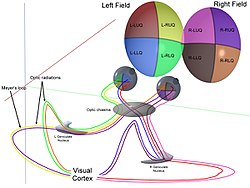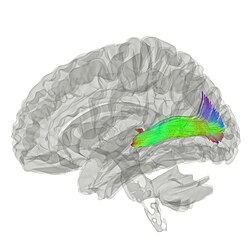This article includes a list of references, related reading, or external links, but its sources remain unclear because it lacks inline citations. (May 2015) |
In neuroanatomy, the optic radiation (also known as the geniculocalcarine tract, the geniculostriate pathway, and posterior thalamic radiation) are axons from the neurons in the lateral geniculate nucleus to the primary visual cortex. The optic radiation receives blood through deep branches of the middle cerebral artery and posterior cerebral artery.
| Optic radiation | |
|---|---|
 Colour-coded diagram showing radiations in quadrants from retinal disc through the brain | |
 Tractography showing optic radiation | |
| Details | |
| System | Visual system |
| Function | Vision |
| Identifiers | |
| Latin | radiatio optica |
| NeuroNames | 1440 |
| TA98 | A14.1.08.673 A14.1.09.542 A14.1.09.547 |
| TA2 | 5584 |
| FMA | 61941 |
| Anatomical terms of neuroanatomy | |
They carry visual information through two divisions (called upper and lower division) to the visual cortex (also called striate cortex) along the calcarine fissure. There is one set of upper and lower divisions on each side of the brain. If a lesion only exists in one unilateral division of the optic radiation, the consequence is called quadrantanopia, which implies that only the respective superior or inferior quadrant of the visual field is affected. If both divisions on one side of the brain are affected, the result is a contralateral homonymous hemianopsia.
Structure
editThe upper division:
- Projects to the upper bank of the calcarine fissure, called the cuneus
- Contains input from the superior retinal quadrants, which represents the inferior visual field quadrants
- Transection causes contralateral lower quadrantanopia
- Lesions that involve both cunei cause a lower altitudinal hemianopia (altitudinopia)
The lower division:
- Loops from the lateral geniculate body anteriorly (Meyer's loop), then posteriorly, to terminate in the lower bank of the calcarine sulcus, called the lingual gyrus
- Contains input from the inferior retinal quadrants, which represents the superior visual field quadrants
- Transection causes contralateral upper quadrantanopia
- Transection of both lingual gyri causes an upper altitudinal hemianopia
Parts
editA distinctive feature of the optic radiations is that they split into two parts on each side:
| Source | Path | Information | Damage |
|---|---|---|---|
| Fibers from the inferior retina (also called "Meyer's loop" or "Archambault's loop") | must pass through the temporal lobe by looping around the inferior horn of the lateral ventricle. | Carry information from the Superior part of the visual field | A lesion in the temporal lobe that results in damage to Meyer's loop causes a characteristic loss of vision in a superior quadrant (quadrantanopia or "pie in the sky" defect.) |
| Fibers from the superior retina* | travel straight back through the parietal lobe to the occipital lobe in the retrolenticular limb of the internal capsule to the visual cortex. | Carry information from the Inferior part of the visual field | Taking the shorter path, these fibers are less susceptible to damage. Damage caused is characteristically called "Pie in the floor" defect or inferior quadrantanopia. |
*Note: In 2009, an anonymous medical doctor edited the "Optic Radiation" Wikipedia article and added the eponymous name "Baum's loop," referring to the dorsal bundle. Despite the information being unverified, this name subsequently entered scholarly articles and textbooks and persisted until three radiologists discovered the fabrication in 2020.[1]
Function
editThe optic radiation contains feedforward tracts that transmit visual information (from the retina of the eye) from the geniculate nucleus to the visual cortex, and also feedback tracts from the visual cortex to the neurons in the LGN that project to them.[2] The function of the feedback from the visual cortex back to the LGN is unknown. The optic radiation is activated during working memory tasks.[3] The optic radiations are usually unilateral and commonly vascular in origin. Field defects, therefore, develop abruptly, in contrast to the slow progression of defects associated with tumors.
Clinical significance
editExamination
editTracts contained within the optic radiation are examined as part of a cranial nerve examination.
See also
editReferences
edit- ^ Knipe, H. C.; Bell, D. J.; Gaillard, F. (2021-02-01). "Letter to the editor: the origin of "Baum's loop"". Surgical and Radiologic Anatomy. 43 (2): 307. doi:10.1007/s00276-020-02587-4. ISSN 1279-8517. PMID 32995937.
- ^ Briggs, Farran; Usrey, W. Martin (2011). "Corticogeniculate feedback and visual processing in the primate". The Journal of Physiology. 589 (1): 33–40. doi:10.1113/jphysiol.2010.193599. ISSN 0022-3751. PMC 3039257. PMID 20724361.
- ^ Wang, Yanming; Wang, Huan; Hu, Sheng; Nguchu, Benedictor Alexander; Zhang, Du; Chen, Shishuo; Ji, Yang; Qiu, Bensheng; Wang, Xiaoxiao (2024). "Sub‐bundle based analysis reveals the role of human optic radiation in visual working memory". Human Brain Mapping. 45 (11). doi:10.1002/hbm.26800. ISSN 1065-9471. PMC 11295295. PMID 39093044.
External links
edit- Kier LE, Staib LH, Davis LM, Bronen RA (1 May 2004). "MR Imaging of the Temporal Stem: Anatomic Dissection Tractography of the Uncinate Fasciculus, Inferior Occipitofrontal Fasciculus, and Meyer's Loop of the Optic Radiation". Am J Neuroradiol. 25 (5): 677–691. PMC 7974480. PMID 15140705. Retrieved 2007-12-19.
- https://web.archive.org/web/20070512234857/http://www2.umdnj.edu/~neuro/studyaid/Practical2000/Q34.htm
- A 3D model of optic tract and optic radiation